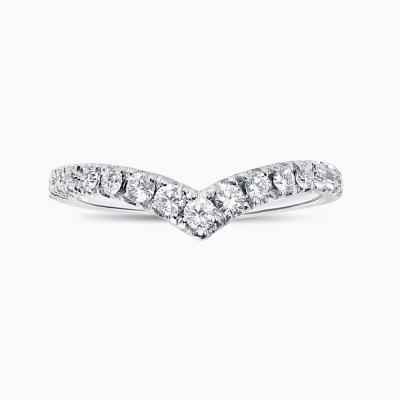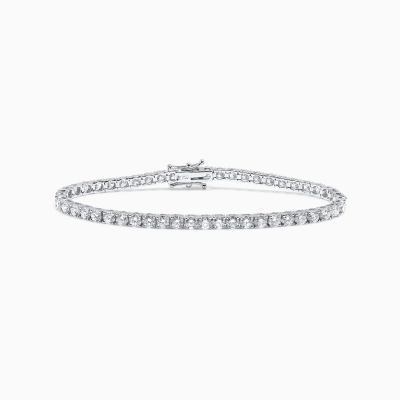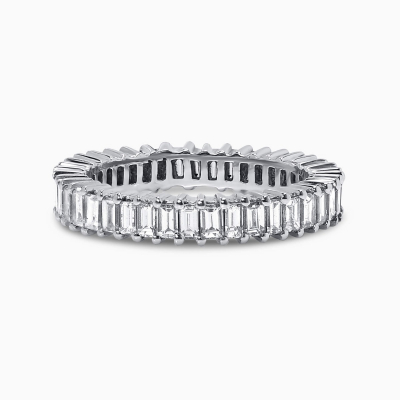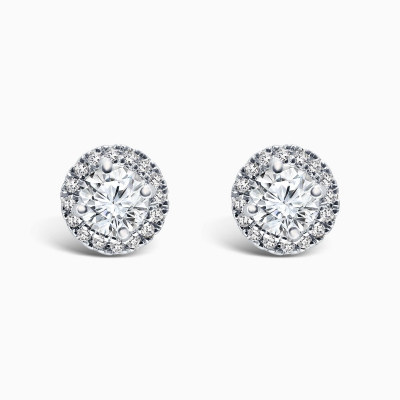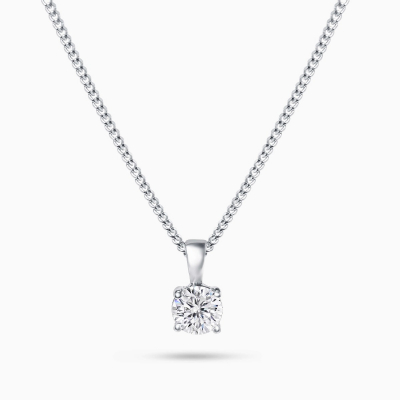USD
/
USD
/
Shipping to:
Currency:
DIAMOND SHAPES GUIDE
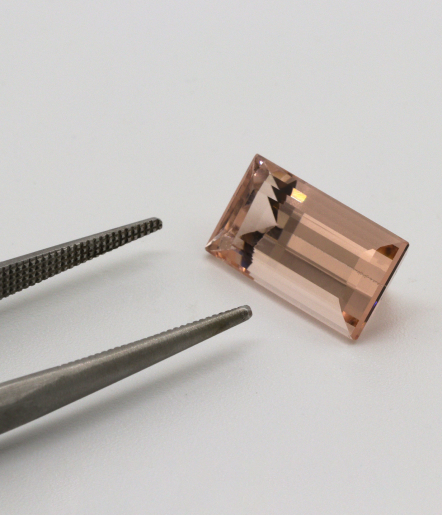
When choosing the perfect diamond engagement ring for your loved one the first decision that will usually be made is the shape of the diamond. The shape of a diamond influences it’s aesthetic appearance, sparkle and brilliance, as well as the price per carat that you will pay.
There are 11 shapes of diamond to choose from offering a shape for every taste, style and budget. Whether you prefer the simplicity of a traditional round shape or one of the fancy shapes such as pear, oval or trillion shaped diamonds, each shape has its own unique characteristics, disadvantages and advantages to be considered when making your choice.
Here is our handy guide to diamond shapes that will help you in choosing the perfect diamond shape for your jewelry. And if you need further assistance with this please don’t hesitate to contact our team of diamond experts.
Round Brilliant
The Round Brilliant shape is by far the most popular choice for diamond engagement rings and over two thirds of diamonds sold are of this shape. Perhaps the major reason for the popularity of the Round Brilliant cut diamond is it’s incredible brilliance as it’s shape allows for maximum reflection and refraction of light. This is created by the 58 facets cut into the diamond which ensure the optimum movement of light through the diamond so giving it the highest level of scintillation of all the shapes of diamond. The Round Brilliant shape has a timeless classic look and is therefore the perfect choice for engagement rings, necklaces and pendants.
Princess
This shape of diamond is second in popularity to the Round Brilliant and is the most popular of the fancy shapes. The Princess cut is relatively modern having been developed in it’s current form in the 1960s. It is essentially a square version of the Round Brilliant cut created from an inverted pyramid of a rough diamond - rectangular Princess cuts are also available.
Princess shape diamonds are usually cut with 57 facets which produce a diamond with stunning brilliance and fire. Due to the larger yield that is maintained when cutting a Princes shape, the per carat price is usually lower than that of the Round Brilliant cut which adds to its popularity. Due to its shape damage to the corners of a Princess diamond is a risk, therefore we always suggest setting a Princess diamond with prongs at all four corners. An advantage of this setting is that any inclusions will be hidden by the prongs.
EMERALD
The Emerald cut uses a technique that was originally designed to cut emeralds and is referred to as a step cut. The step cuts in this diamond shape are unlike those found in other cuts such as the Princess or Round Brilliant as they highlight the clarity and purity of the diamond.
This shape has a large table surface and it’s long facets produce dramatic reflections of light through these ‘steps’. Emerald cuts are rectangular with the corners cut which gives this shape a truly stunning sophisticated elegance. This shape also showcases the size of the diamond far better than other diamonds with the same carat which makes the Emerald cut the perfect choice for those looking for a diamond engagement ring with a larger centre stone without a very large price tag.
ASSCHER
The Asscher shape was developed by the Asscher brothers in Holland in 1902 for the Art Deco design era. It had a resurgence in popularity in 2002 when it’s first 100th anniversary was celebrated with a small modification to the cut which brought it up to date.
Asscher cut diamonds exhibit wide step facets and cropped corners which create extra stability, style, and a perfect square shape. For this reason Asscher shape diamonds are sometimes referred to as ‘Square Emerald Cut’. However, they have a smaller table and more layered facets than Emerald Cut diamonds and their brilliance is achieved by light reflection among the square facets seen underneath the table.
The distinctive 58 facet cut of Asscher diamonds and high crown means that the natural beauty of the diamond is highlighted to its full potential offering a bit more sparkle than the similar Emerald cut.
Pear
Often referred to as 'teardrop' diamonds because of their shape, Pear shaped diamonds are an elegant and classic cut that are just perfect for a sophisticated lady.
As their name suggests, they have a rounded side narrowing to a point which when set in an engagement ring traditionally points towards the heart.
Symmetry is a very essential part in the creation of a Pear shaped diamond and the ratio recommended for this stone is between 1.5 and 1.7. This ensures a full shape that isn’t too narrow but ends with an even neat point. 56 to 58 facets are cut into the Pear shape which optimizes sparkle and light reflection. As the Pear shape is slightly shallower than other fancy shapes such as the Princess or Round Brilliant cut, bigger measurements are achieved which make this shape excellent value for money. Plus the Pear shape hides inclusions well.
Radiant
Radiant shape diamonds are the perfect choice for a lady with an active lifestyle as their bevelled corners provide for more stability. This shape became popular during the 1980s largely due to their amazing brilliance and fire which is created by the many facets and angles present in the crown and pavilion of the diamond. These give the diamond the appearance of cracked ice which is very striking in a contemporary design of engagement ring. The Pear shape also looks stunning when set with square or rounded diamonds.
Oval
The Oval shape diamond engagement ring rose to popularity in the 1960s and is a great choice for those who like to wear jewelry with a touch of the unique. It is also highly durable having no pointed edges.
The Oval shape is part of the brilliant cut family which has been elongated to form the Oval shape so giving the appearance of a larger diamond in comparison to other shapes of the same carat. The Oval cut aligns 58 facets causing a bow tie effect in the middle of the diamond. This shape is perfect for those looking for sparkle on a budget and works well with diamond solitaire engagement rings or more elaborate designs such as halo diamond engagement rings.
Cushion
The Cushion shape diamond derives it’s name from its resemblance to a pillow as it is rectangular or square in shape with rounded edges. It’s a very popular shape as it combines tradition with fashion.
Generally exhibiting 58 facets this diamond shape bends and disperses light to gives the give a fiery crushed ice effect that is truly mesmerizing.
When choosing a Cushion shape diamond we always advise selecting a diamond with a depth and table both under 70% which will ensure the maintenance of fire and brilliance through the diamond’s depth.
Heart
Considered the ultimate symbol of love, the Heart shaped diamond makes an exquisite and elegant centre piece in a diamond engagement ring, pendant or other piece of diamond jewelry.
A Heart shape diamond is comprised of between 56 and 58 facets and can be designed in a variety of widths and slenderness. The important factor to look for when selecting a Heart shaped diamond is that it is symmetrical so that the diamond appears full yet balanced, and the point or cleft must be distinct. Higher carats are best for you Heart shaped diamonds due to its form such as one of two. If a smaller carat is used then a three prong setting is best to be used to highlight the heart outline.
Marquise
The Marquise shape diamond is steeped in history. It was originally commissioned in the 1700s by King Louis XIV of France to replicate the mouth of his mistress.
In the 20th Century the shape was further refined to produce the sparkle that we see in today’s Marquise cut diamonds. It is a variation of the Round Brilliant shape and has two pointed ends at the top and bottom of the diamond which must be aligned almost perfectly with each other.
A Marquise shape diamond is the perfect complement to a solitaire engagement ring or set within smaller diamonds. This shape very much suits ladies with smaller hands as the large crown of the Marquise shape has the effect of elongating the fingers. Due to its elongated shape, the Marquise cut also gives the appearance of a larger diamond in comparison to other shapes of the same carat.
Trillion
Trillion shape diamonds make a dramatic and bold statement within a diamond engagement ring or other piece of fine diamond jewelry. They are a very unique shape being totally different from square, rectangle or round shaped diamonds. Although often seen as an accent or complementary side stones, Trillion shape diamonds do sit beautifully in their own right and with their exquisite brilliance and depth of fire are a very impressive cut.
As a centerpiece diamond, a Trillion shape needs to be set with the edges protected by prongs due to its width which also works to make the Trillion look larger than diamonds of the same carat.
UNUSUAL SHAPES
Flanders Cut diamonds are a relatively new diamond cut being created by a gemologist in 1983. It was polished for the very first time in 1987 by a small diamond polishing factory located in Antwerp hence its name which reflects this northern region of Belgium – Flanders. Flanders Cut diamonds have 61 stunning facets which mean that this cut takes one third more time to cut than, for example, the Round Brilliant Cut. Flanders Cut diamonds are renowned for their stunning brilliance and the facets need to be perfectly positioned to ensure that the diamond catches the light to maximize sparkle. The deep pavilion of Flanders Cut diamonds improve reflection of light within the diamond and the upper facets on the crown enhance the diamonds fire. Together these factors produce an absolutely diamond full of sparkle and fire.









